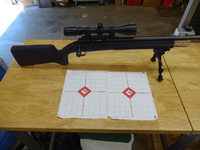Bronze Supporter
- Messages
- 5,213
- Reactions
- 13,522
Must be time for a new gun then! The correct number of guns after all is just one more.I also dont have anything else to do with my new reloading gear once I develop this hunting load.
Follow along with the video below to see how to install our site as a web app on your home screen.
Note: This feature may not be available in some browsers.
Must be time for a new gun then! The correct number of guns after all is just one more.I also dont have anything else to do with my new reloading gear once I develop this hunting load.

what he said. i had a 3006 that i had a 168 MK load for that would or could shoot .500 groups at 100 yardsHaving spent many years reloading for competition accuracy many other factors will have a much larger affect on accuracy than 1/10th grain variance in projectile. Such as Bullets. Match bullets like Sierra Match Kings or Bergers. Brass manufacture and/or lot number will make a huge difference in accuracy. Primer manufacture. Each load may prefer one
brand of primer. Different loads will prefer different primers. Reloading equipment type and brand used affects bullet
concentricity. Last but not least is shooter skill and equipment used. Rifle, scope, mount and bench rest set up. Good
luck have fun.
Stock 308 Savage 5 rounds at 100 yards.
View attachment 998521
I also dont have anything else to do with my new reloading gear once I develop this hunting load. If I can quantify something that improves my precision, I'll do it.
There always seems to be something else to do with your reloading gear, if you love to reload. A new gun always works. Trying a different bullet/powder/primer/case in the same gun also works. Just trying different experiments with the same gun/load also works. Some people find a good load, build a bunch of them, and are done. You sound like the type of person (like me) who finds a load, builds a few, finds something else to tweak, builds a few more, and so on. Never build too many, because the moment you do you'll discover something different about your process and you'll feel compelled to strip those loads back down. Ask me how I know. Enjoy!Must be time for a new gun then! The correct number of guns after all is just one more.
What I should have asked is what kind of projectile weight tolerance is noticeable. Now for my application my minimum goal is 1MOA... which I think is achievable. If say... +/- 3/10gr projectile weight stays within 1MOA then Im fine with lumping them all together. Not that I would complain if my reloading will get me less than half MOA... It might, I just dont have enough data points yet to know..I agree with the general tenor that 0.1gr bullet weight is not an issue with hunting bullets. But regardless, don't throw any away. You've binned them into representative piles and you're using one pile for load development. Once that load is developed, you can shoot the other bins. You might see a tiny change in POI (might), but you will still be adhering to the accuracy-enhancing practice of using a consistent set of components.
If you're really curious what 0.1gr difference in weight might do, plug some scenarios into a ballistics calculator and see how the POI changes with a change in projectile weight. Use an offsetting change in velocity as well, if you feel you can estimate it. Then look at the practical difference at 300, 600, 1000 yards - whatever makes sense with regards to your hunting range. I'm guessing the calculated difference will be itty-bitty at relevant ranges.
There always seems to be something else to do with your reloading gear, if you love to reload. A new gun always works. Trying a different bullet/powder/primer/case in the same gun also works. Just trying different experiments with the same gun/load also works. Some people find a good load, build a bunch of them, and are done. You sound like the type of person (like me) who finds a load, builds a few, finds something else to tweak, builds a few more, and so on. Never build too many, because the moment you do you'll discover something different about your process and you'll feel compelled to strip those loads back down. Ask me how I know. Enjoy!
That was barrel maker Harry M. Pope and it was more like 30,000 shots with one piece of brass using one of his 30-40 Ballard guns. Cast bullets/powder charges by volume.Without a Ransom rest or the like, (and maybe not even then) Even in my younger years, It would be difficult for me to claim accuracy upset over .1 grain difference., Though I hear your quest for perfection, and can relate..
Not being concentric, unbalanced, poor seating or other manufactured or procedural failings would be a different story.
As an aside; I have been using primarily Nosler polycarbonate tipped projectiles on most all my rifles without issue for their game expansion, and accuracy, since they first were made available to the public. (You'd think I'd own stock by now) I have long since stopped measuring and weighing them considering them "good enough" for me....again, for me.
Not to suggest anything disparaging about Speer, Hornady or Barns which I have also had good performance with, but keep going back to Nosler.
There was a benchrester, nearly a hundred years ago now, that went to trials and hand loaded the same brass shell over and over till the match was finished. That seems somewhere between dedication to perfection and insanity.
